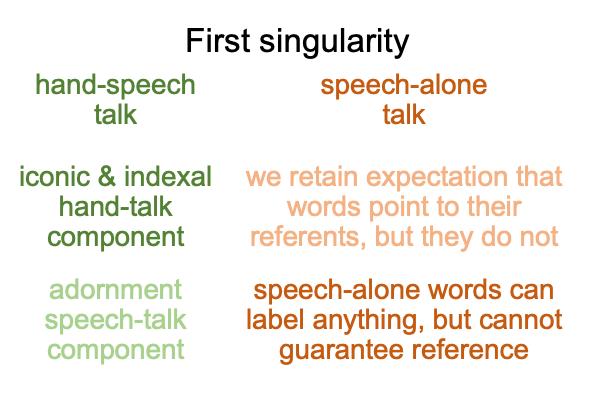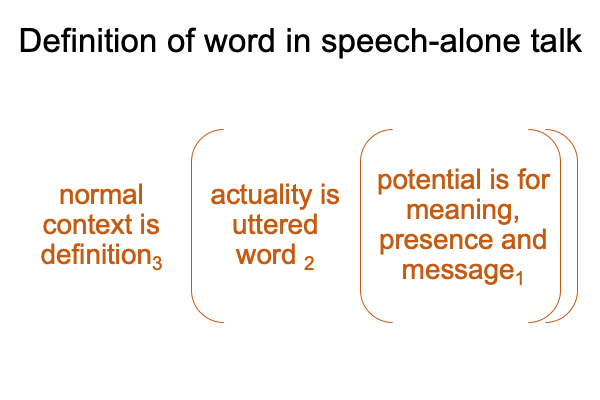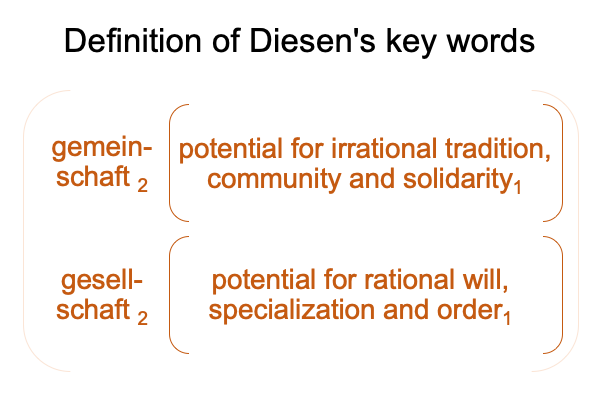0013 Already, the hypothesis of the first singularity enriches Diesen’s theory that civilization generates, maintains, distorts and loses balance between gemeinschaft and gesellschaft. The distinction between hand talk and speech talk is built into the unity of hand-speech talk. Distinction within a unity is natural to us. But, it is impossible to convey using speech-alone talk. Once both elements of a distinction are labeled, one has difficulty visualizing the unity.
For example, in Razie Mah’s May 2023 blog, Looking at Heather Heying and Bret Weinstein’s Book (2020) A Hunter Gatherer’s Guide to the 21st Century, Diesen’s distinction is described as between culture (gemeinschaft) and consciousness (gesellschaft), rather than irrational tradition and rational bureaucracy.
0014 Why is it so easy to attach labels to two sides of a distinction, then forget the unity?
Our kind adapts to a distinction within unity, not to each separate element.
Yet, only the distinct elements are labeled using speech-alone talk. Subsequent explicit abstraction in our current Lebenswelt takes only the separate, labeled elements into account.
The unity is no longer apparent.
0015 The hypothesis of the first singularity proposes that hand-speech talk characterizes the Lebenswelt that we evolved inand that speech-alone talk associates to our current Lebenswelt.
Here is a picture of talk, before and after the first singularity.

0016 In the Lebenswelt that we evolved in, the technical terms, “gemeinschaft” and “gesellschaft” could not be imaged or indicated using hand talk. Yet, the distinction between them are built into to the nature of a dual-mode for talking. The hand-talk component primarily delivers meaningful content, but also conveys emotion and personal presence. The speech-talk delivers the same content as hand talk, but adds something that is um… like a message. The message concerns intention. Hear me as well as see me.
Hand-talk may say, “OLAF BOAR GORE”, and the utterer may appear shaken. But, the reply, in speech talk, “Olaf boar gore.” transubstantiates the content, without distortion, to a musical register, singing of an alignment, which must be accepted. A boar has gored Olaf. The One Who Gives, Without Us Knowing Why, is also The One Who Determines What Cannot Be Imaged Or Pointed To. That is our “fate”.
The term, “fate”, cannot be pictured or pointed to in hand talk.
Our kind adapts to ‘something’ in the Lebenswelt that we evolved in.
We label that ‘something’, “fate”, in our current Lebenswelt.
0017 Likewise, in our current Lebenswelt, the technical terms, “gemeinschaft” and “gesellschaft” seem to image and indicate their referents. But, those references really exist in the realm of possibility, rather than actuality. In hand talk, an actual referent precedes the manual-brachial word-gesture. Not so in speech-alone talk, where speech-alone words are purely symbolic. They can label anything. But, that reference is not guaranteed. It always remains in the realm of possibility.
0018 A Primer on the Category-Based Nested Form allows me to depict the the nature of spoken words as a triadic relation. This particular depiction stands in the introduction of Razie Mah’s masterwork, How To Define the Word “Religion”. These works are available at smashwords and other e-book venues.

0019 When Diesen writes these technical terms, it seems to me that, in his mind, he actualizes the possibilities. He knows what “gemeinschaft” and “gesellschaft” mean. And, I wonder, “Do they mean what I am suggesting here? Are these labels attached to something that cannot be pictured and pointed to?”
Well, no… and… yes.
Gemeinschaft is not like hand-talk. Gemeinschaft is primal, body-oriented, directly connected to emotions, working and looking at others… well, maybe gemeinschaft is like the gestural-component of hand talk.
Gesellschaft is not like speech-talk. Gesellschaft is adornment, song-oriented, directly connected to the congregation… er, social circle, breathing and sounding in unison… well, maybe gesellschaft is like the spoken aspect to hand-speech talk.
0020 Speech-alone talk changes our Lebenswelt.
Gemeinschaft includes people who work with their hands, people who walk and eat and live together, and people who worship the same God, the God Who Gives, Without Us Knowing Why and the God Who Establishes My Fate. This God has a spoken name. In our current Lebenswelt, this God can turn to you or me and ask, “Who do people say that I am?”
Gesellschaft includes people who work with their… tongues?… well, how about this?… people who work with their minds, such as inventors and bureaucrats, entrepreneurs and accountants, honest brokers and lawyers, pastors and politicians, mentors and professors and on and on. The range of specializations, both labor and social, boggle the mind. These professionals are educated. They are often very interested in controlling the language, because spoken words order reality. Plus, the experts are fully capable of destroying tradition, community and solidarity on the basis of their “rational” theoretical schemes. Today, in 2023, Russians know all about that. Americans are just learning.
0021 Here is a picture of the actuality2 and potential1 for Diesen’s key terms.

0022 Diesen describes civilization as a balancing act between the potentials underlying these two spoken words.
